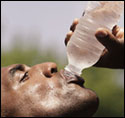Water: Meeting Your Daily Fluid Needs |
|
 Ever notice how lifeless a house plant looks when you forget to water it?
Just a little water and it seems to perk back up. Water is just as essential
for our bodies because it is in every cell, tissue, and organ in your body.
That's why getting enough water every day is important for your health.
Ever notice how lifeless a house plant looks when you forget to water it?
Just a little water and it seems to perk back up. Water is just as essential
for our bodies because it is in every cell, tissue, and organ in your body.
That's why getting enough water every day is important for your health.
Healthy people meet their fluid needs by drinking when thirsty and drinking
fluids with meals. But, if you're outside in hot weather for most of the day
or doing vigorous physical activity, you'll need to make an effort to drink
more fluids.
Where do I get the water I need?
Most of your water needs are met through the water and beverages you
drink.
You can get some fluid through the foods you eat. For example, broth soups
and other foods that are 85% to 95% water such as celery, tomatoes, oranges,
and melons.
What does water do in my body?
Water helps your body with the following:
- Keeps its temperature normal.
- Lubricates and cushions your joints.
- Protects your spinal cord and other sensitive tissues.
- Gets rid of wastes through urination, perspiration, and bowel movements.
Why do I need to drink enough water each day?
You need water to replace what your body loses through normal everyday
functions. Of course, you lose water when you go to the bathroom or sweat,
but you even lose small amounts of water when you exhale. You need to
replace this lost water to prevent dehydration.
 Your body also needs more water when you are—
Your body also needs more water when you are—
- In hot climates.
- More physically active.
- Running a fever.
- Having diarrhea or vomiting.
To help you stay hydrated during prolonged physical activity or when it is hot outside, the Dietary Guidelines for Americans 2005 recommend these two steps:
- Drink fluid while doing the activity.
- Drink several glasses of water or other fluid after the physical activity is completed.1
Also, when you are participating in vigorous physical activity, it's
important to drink before you even feel thirsty. Thirst is a signal that
your body is on the way to dehydration. For more information, visit
Fit Facts, Healthy Hydration from the American Council on Fitness.*![]() (PDF-1.4Mb)
(PDF-1.4Mb)
Some people may have fluid restrictions because of a health problem, such as
kidney disease. If your healthcare provider has told you to restrict your
fluid intake, be sure to follow that advice.
Tips for Increasing Your Fluid Intake by Drinking More Water
 Under normal conditions, most people can drink enough fluids to meet
their water needs. If you are outside in hot weather for most of the day or
doing vigorous activity, you may need to increase your fluid intake.
Under normal conditions, most people can drink enough fluids to meet
their water needs. If you are outside in hot weather for most of the day or
doing vigorous activity, you may need to increase your fluid intake.
If you think you're not getting enough water each day, the following tips
may help:
- Carry a water bottle for easy access when you are at work or running errands.
- Freeze some freezer-safe water bottles. Take one with you for ice-cold water all day long.
- Choose water instead of sugar-sweetened beverages. This tip can also help with weight management. Substituting water for one 20-ounce sugar-sweetened soda will save you about 240 calories.
- Choose water instead of other beverages when eating out. Generally, you will save money and reduce calories.
- Give your water a little pizzazz by adding a wedge of lime or lemon. This may improve the taste, and you just might drink more water than you usually do.
Do sugar-sweetened beverages count?
 Although beverages that are sweetened with sugars do provide water, they
usually have more calories than unsweetened beverages. To help with weight
control, you should consume beverages and foods that don't have added
sugars.
Although beverages that are sweetened with sugars do provide water, they
usually have more calories than unsweetened beverages. To help with weight
control, you should consume beverages and foods that don't have added
sugars.
Examples of beverages with added sugars:
- Fruit drinks.
- Some sports drinks.
- Soft drinks and sodas (non-diet).
Visit Rethink Your Drink for more information about the calories in beverages and how you can make better drink choices to reduce your calorie intake.
Sources
1HHS & USDA. Dietary Guidelines for Americans, 2005. Chapter
2: Adequate Nutrients Within Calorie Needs. Accessed online May 24, 2007:
http://www.health.gov/dietaryguidelines/dga2005/document/html/chapter2.htm
U.S. National Library of Medicine & NIH. MedlinePlus Medical Encyclopedia:
Water in Diet.
http://www.nlm.nih.gov/medlineplus/ency/article/002471.htm
![]() Please note: Some of these publications are available for download only as *.pdf files. These files require Adobe Acrobat Reader in order to be viewed. Please review the information on downloading and using Acrobat Reader software.
Please note: Some of these publications are available for download only as *.pdf files. These files require Adobe Acrobat Reader in order to be viewed. Please review the information on downloading and using Acrobat Reader software.
* Links to non-Federal organizations found at this site are provided solely as a service to our users. These links do not constitute an endorsement of these organizations or their programs by CDC or the Federal Government, and none should be inferred. CDC is not responsible for the content of the individual organization Web pages found at these links.
Page last updated: March 6, 2008
Content Source: Division of Nutrition, Physical Activity and Obesity, National Center for Chronic Disease Prevention and Health Promotion


